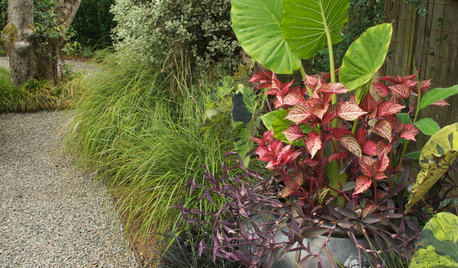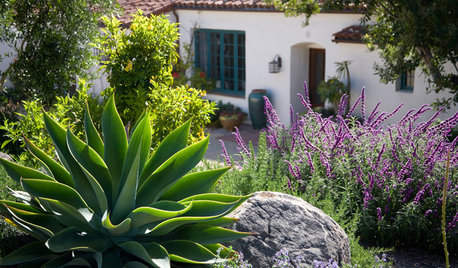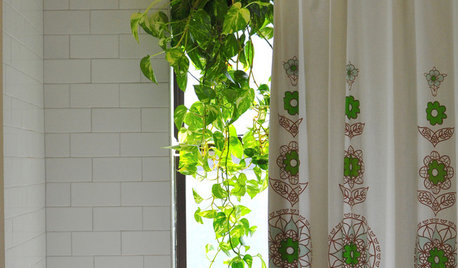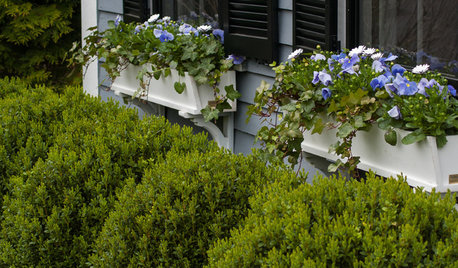Miracle Gro LIQUAFEEDER question for my pots
piper101
14 years ago
Featured Answer
Comments (27)
justaguy2
14 years agopiper101
14 years agoRelated Discussions
MiracleGro Potting Mix versus SuperSoil Potting Soil ???
Comments (9)Do you have an easy recipe of making your own mix for a gardening-beginner? Yes. I would recommend using what is known around here as 'Al's 5-1-1 mix' for annuals and perennials grown for just a year or two before being repotted. For plants that will stay in the same container/mix for more than 2 years I would recommend what is known around here as 'Al's Gritty mix'. The 5:1:1 mix is 5 parts pine bark (very small pieces), 1 part perlite and 1 part peat. The gritty mix is 1 part pine bark fines, 1 part Turface MVP and 1 part grower grit (#2 sized). For more information on this I will refer you to this thread. Don't get too hung up on specific ingredients and percentages. The principle is using ingredients that will be of a large enough size (above 1/16th inch) for as long as the plant will be in the mix. This provides superior aeration. The higher the percentage of organic matter such as peat or bark, the faster the mix breaks down and aeration suffers. The bark breaks down much slower than peat though. Anyway, read the thread and you will learn a lot. If you can't find suitable ingredients to make your own mix in time to get the season started then just get the regular MG potting mix and take until next year to learn more and locate sources for ingredients you want....See MoreA question for Raybo re Miracle Gro potting mix
Comments (2)Hi Liz, The Miracle Grow fertilizer really contains "trace elements" of fertilizer. Enough to last a month or two, but not anywhere sufficient for raising a season of tomatoes or corn. If you follow the Rev 1.4 planting instructions, (1 cup Dolomite Lime to combat BER, and 1 cup Tomato-tone in a strip around the perimeter of the outer cage legs), you should be in good shape. Some other DYI sites recommend 2 cups of fertilizer in a thick strip, but my experience is that this is too much and can burn the plants. My reduced amount will limit plant burn. You can always add some more as you get fruit-set, via a root drench, but I would err on the side of too little rather than too much. Raybo...See MoreMiracle Gro 'Moisture Control' Potting Soil
Comments (37)Hi aptosca - It said - for potted plants. How are you to know that doesn't mean house plants? That was one of your questions. The terms potted plants and house plants are often used interchangeably, but there is a difference. All houseplants are potted, but not all potted plants are grown in the house; many people have potted plants outside, on patios and porches, or summering their houseplants outside, or just growing-on plants for size or whatever - many reasons. Plants grown outside in pots tend to dry out faster than plants grown indoors, and that's why some people prefer "water retentive" soils for outdoor potted plants. But one thing is true outdoors or indoors - wet soil that never dries out makes for wet roots, and wet roots make for dead plants. As you can see from reading all of this thread, there's a lot of 'different strokes for different folks.' It's one reason that you find so much conflicting information if you do much research. One thing that's absolutely true, though, is that if roots stay too wet, plants die. But... That's not always true, either, because many plants are incredibly, amazingly adaptable. Species that are known to hate "wet feet" sometimes adapt to living in a constantly wet - I mean soaking wet - pot. I know, I have one. This is another source of much conflicting information. My advice to you would be to try what seems reasonable to you, what seems to fit your own requirements best. If things don't work as well as you would like, try something else. Even if you are satisfied with results, go ahead and try something different, just as an experiment. That's one reason you never get tired of working with plants, once you get into it....See MoreSquirrels in sta-green potting mix vs miracle-gro potting mix
Comments (3)The same thing happened to me too this year. I have used Miracle-Gro for years. This year,like an idiot, I decided to try Sta-Green.I used it once years ago and did not like it then. The squirrels love it! I may have to repot my potted plants. Right now I am putting huge quantities of cayenne pepper in the pots. At least that works....See Moretapla (mid-Michigan, USDA z5b-6a)
14 years agopiper101
14 years agopiper101
14 years agotapla (mid-Michigan, USDA z5b-6a)
14 years agopiper101
14 years agoPieonear
14 years agotyler_thulin_gmail_com
12 years agohutch_zukiworld_com
12 years agoHome and Garden spaces
8 years agodale92539 Riverside Co SoCal
8 years agolast modified: 8 years agoVicky Laursen
7 years agodale92539 Riverside Co SoCal
7 years agoVicky Laursen
7 years agoVicky Laursen
7 years agotapla (mid-Michigan, USDA z5b-6a)
7 years agodale92539 Riverside Co SoCal
7 years agolast modified: 7 years agoVicky Laursen
7 years agoVicky Laursen
7 years agobragu_DSM 5
7 years agorobert sobus
7 years agolast modified: 7 years agoHome and Garden spaces
5 years agoHU-422285460
3 years agoHU-422285460
3 years agoJoy Klinger
3 years agolast modified: 3 years ago
Related Stories

CONTAINER GARDENSSolve Your Garden Border Dilemmas With Planted Pots
Set your containers free from the patio — placed among plantings in the ground, they fill unsightly gaps, let you experiment and more
Full Story
GARDENING GUIDESCommon Myths That May Be Hurting Your Garden
Discover the truth about fertilizer, soil, staking and more to keep your plants healthy and happy
Full Story
MOST POPULARThe Perfect Houseplant for People Who Kill Houseplants
If you can fill a jar with water, you can keep golden pothos vine happy — and it will pay you back with cleaner air and a greener home
Full Story
GARDENING GUIDESMake Sure You Read This Before Buying New Plants
Follow these 10 plant-selection tips to avoid buyer’s remorse
Full Story



tapla (mid-Michigan, USDA z5b-6a)